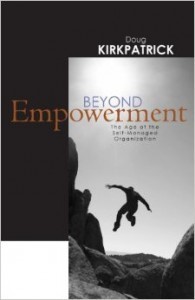The Problem With Empowerment
by Rod Collins
Many, if not most, businesses today share a common and troubling problem: The vast majority of the people who work for their organizations are disengaged. According to a recent Gallup study, worldwide, a meager 13 percent of workers are engaged at work. In other words, only one out of every eight employees are motivated to make positive contributions to their organizations. While 63 percent of workers described themselves as “not engaged” in the workplace, an alarming 24 percent are “actively disengaged” and may actually be thwarting the productivity of their companies.
Although there are regional differences, no area is experiencing outstanding results when it comes to leveraging the talents of their workers. In the top-performing region—the United States and Canada—the level of engaged workers is still a dismally low 29 percent. These results are not good news for business leaders struggling to keep pace with fast-moving markets that are changing much faster than their organizations. If they are to have any hope of closing this change gap, business leaders are going to need to find a way to get the vast majority of their employees committed to the success of their companies.
A Limited Solution
One solution that some business leaders are embracing is to retrain their managers in the principles and practices of empowerment. The thinking is that, if managers get better at including workers in defining what needs to be done and how to do the work, the level of engagement will dramatically improve. While the logic seems to makes sense and the practices often produce short-term results, empowerment is usually limited as a long-term worker engagement strategy because it is overly dependent upon the voluntary cooperation of the managers. Thus, micromanagers who succeed empowering basses can undo the benefits of engagement in a matter of months, or even days.
The problem with empowerment is that it assumes that hierarchies are a given. The voluntary delegation of power is something that can only happen in a hierarchy. If business leaders want a reliable long-term strategy for fostering high levels of worker engagement, Doug Kirkpatrick, the author of Beyond Empowerment: The Age of the Self-Managed Organization, recommends they begin by eliminating the great enabler of worker disengagement: the corporate hierarchy. Kirkpatrick points out that “employee empowerment” implies that one person has the authority to transfer power to another person. It also implies that “what is given can be taken away,” which is why Kirkpatrick prefers what he calls “self-management” over empowerment as a more effective organizational strategy for enabling worker engagement.
Beyond Empowerment
 Beyond Empowerment is a fictionalized account of a company that designs itself as a peer-to-peer network rather than a top-down hierarchy. It is based on the true story of the innovative management model used by the California company Morning Star to propel itself into becoming the world’s largest tomato processor. Kirkpatrick makes a convincing case that self-management is more effective than hierarchical management because it moves beyond empowerment by vesting organizational power in those who actually do the work. In self-managed organizations, every worker is a manager because very worker is directly accountable for delivering value to customers. That’s why the workers at Morning Star are not called “employees,” but rather “colleagues.” Employees are people who work for others for pay, while colleagues are people who unite with others in a common pursuit.
Beyond Empowerment is a fictionalized account of a company that designs itself as a peer-to-peer network rather than a top-down hierarchy. It is based on the true story of the innovative management model used by the California company Morning Star to propel itself into becoming the world’s largest tomato processor. Kirkpatrick makes a convincing case that self-management is more effective than hierarchical management because it moves beyond empowerment by vesting organizational power in those who actually do the work. In self-managed organizations, every worker is a manager because very worker is directly accountable for delivering value to customers. That’s why the workers at Morning Star are not called “employees,” but rather “colleagues.” Employees are people who work for others for pay, while colleagues are people who unite with others in a common pursuit.
Self-management is based upon two primary principles. The first is that “people should not use force against others or their property.” In other words, no one should have the authority to unilaterally impose his or her will upon another person in the company. The second is that “people should keep their commitments to others.” This means that workers are accountable to their peers in meaningful ways. Put simply, self-management is a peer-to-peer structure built upon two core values: freedom and responsibility. Workers are free to associate with anyone else in the company in creating value, and they are free from the coercive behavior that is taken as a given in many traditional management arrangements. With this freedom comes high expectations for acting responsibly on behalf of the customers served by the company. Thus, colleagues are responsible for negotiating internal commitments, measuring their performance against those agreements, and ultimately delivering what they have promised.
Core Values
Freedom is a core value because, according to Kirkpatrick, freedom is “the way humans are wired.” People want to have a say in what they do; they want to help create a world that is better for themselves and others through the work they do together. This is what engagement is all about: having the freedom to shape what we do and collaborate with colleagues to make a real difference in the lives of those we serve. Few workers in traditional organizations have this freedom, which may explain why their engagement levels are dreadfully low.
Responsibility is a core value because, without it, nothing would be accomplished. Self-management is not a structureless approach to designing an organization, but rather a different—and an arguably far more effective—way to design how work gets done. At Morning Star, the primary tool for aligning responsibilities is the “Colleague Letter of Understanding.” Before the beginning of each year, colleagues in each business unit gather to discuss business strategy for the upcoming year and negotiate agreements around measurable deliverables that form the basis of the shared understanding that directs the coordination of the individual efforts of each of the workers. Throughout the year, detailed business information is updated twice a month so that workers can track their own as well as their colleagues’ metrics. This metrics-based peer accountability structure is the foundation for both high worker engagement and sustained business success.
A Better Solution
If business leaders are serious about improving and sustaining high levels of worker engagement, they should reconsider if they are contemplating an employee empowerment initiative. Such initiatives are likely to go the route of other managerial “flavors of the month” for the simple reason that when managers have the authority to give, they also have the authority to take away. Solidifying high worker engagement into the fundamental DNA of the organization will not be accomplished by incremental organizational philosophies that can easily be undone on a managerial whim. Developing robust high engagement work cultures requires a fundamental structural change in the way that power works in organizations. Rather than attempting to build an empowered hierarchy—which is probably an oxymoron—a better solution for business leaders would be to follow Kirkpatrick’s advice by redesigning their organizations as peer-to-peer networks where no one has the authority to empower or disempower anyone else because power comes from being connected rather than from being in charge.
Rod Collins (@collinsrod) is Director of Innovation at Optimity Advisors and author of Wiki Management: A Revolutionary New Model for a Rapidly Changing and Collaborative World (AMACOM Books, 2014).
Rod Collins's Blog
- Rod Collins's profile
- 2 followers




